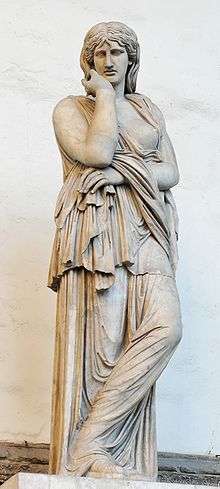Thusnelda


Thusnelda (c. 10 BC - unknown) was a Germanic noblewoman captured by Germanicus, the grandson of Augustus, and leader of an army that invaded Germania. The ancient Roman historian Tacitus and Strabo cites her capture as evidence of both the firmness and restraint of Roman arms.
She was the daughter of the Cheruscan prince Segestes. Her father had intended her for someone else, but Arminius had abducted and impregnated her. Arminius subsequently led a coalition of Germanic tribes that lured the legions of Publius Quinctilius Varus to near-annihilation at Battle of Teutoburg Forest in 9 AD. This disaster generally is seen as stifling any future ambitions of Rome to conquer Germania.
The war between the Roman Empire and the northern German tribes continued, and in May 15 AD Thusnelda was captured by Germanicus, the nephew of Emperor Tiberius, who commanded the invasion of Germany. She was pregnant and staying with her father, who was a Roman client and bitterly opposed to Arminius, and it was her father who delivered her to Germanicus, after the latter saved him by driving off Arminius' forces, who had besieged him.[1] Her husband much grieved over her loss and did not marry again.
During her captivity, Thusnelda gave birth to her and Arminius' only child, Thumelicus. On May 26, 17 AD, Thusnelda and her son were displayed as prized trophies of the triumph granted to Germanicus; during the triumph's parade, her father was forced to watch from the stands. The contemporary historians seem to evidence a discomfort with her display as evidence of a German victory, instead of the capture of Arminius. The next year, just prior to the Battle of the Weser River, Arminius engaged in a famous disputation with his brother Flavus, who was still serving in the Roman army. Flavus informed Arminius that Thusnelda was being well-treated — as, he claimed, was typical of Rome, which was a firm but fair ruler.
Thumelicus was trained at the gladiator school in Ravenna and is believed to have died in a gladiator show at a fairly young age. Tacitus tells us that he will report on Thumelicus' fate "at the proper time" — i.e., when he discusses the year in question in his chronicle.[2] The main gap in his text is for 30 and 31 AD — so it could be that Thumelicus died then, aged 15 or 16.
Notes
External links
| Wikimedia Commons has media related to Thusnelda. |
- Thusnelda, part of the Encyclopædia Romana by James Grout.